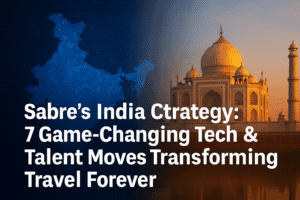Sabre’s India Strategy: 7 Game-Changing Tech & Talent Moves Transforming Travel Forever
Sabre is prioritizing India’s booming travel market by investing in fresh talent from top institutions like IIMs, bypassing traditional hiring from rivals to build a future-ready team. Post-pandemic, Indian travelers increasingly seek premium, self-planned experiences, with domestic tourism surging due to infrastructure upgrades and international visa delays. Corporate travel rebounds through efficient same-day trips and rising demand in tech hubs like Hyderabad, supported by India’s aggressive airport expansion. Sabre’s tech focus includes New Distribution Capability (NDC), enabling airlines like Air India to offer personalized fares and dynamic pricing, while low-cost carriers leverage global distribution systems to balance direct sales with premium international growth. Challenges like talent gaps and sustainability loom, but Sabre’s blend of innovation and local insight positions it to shape India’s travel evolution.

Sabre’s India Strategy: 7 Game-Changing Tech & Talent Moves Transforming Travel Forever
India’s travel industry is undergoing a seismic shift, driven by tech-savvy consumers, infrastructure growth, and post-pandemic aspirations. At the forefront of this evolution is Sabre, the global travel tech giant, which is doubling down on its India strategy. Samual Machado, Sabre’s Managing Director for India and South Asia, shares insights into how the company is navigating this dynamic landscape while shaping its future.
Building Talent for Tomorrow, Not Just Today
While competitors often poach seasoned professionals, Sabre is taking a bold approach: investing in fresh talent from India’s premier institutions like the Indian Institutes of Management (IIMs). Machado emphasizes that Sabre’s Bengaluru Global Capability Center (GCC)—now a cornerstone of its global tech strategy—isn’t just a back-office hub. It’s a breeding ground for innovation.
“We’re not here to replicate the past,” Machado explains. “By nurturing young talent, we’re building a team that can anticipate future challenges, from AI-driven solutions to evolving traveler demands.” This strategy not only fuels Sabre’s growth but also positions India as a critical player in shaping global travel tech.
The New Indian Traveler: Spontaneous, Demanding, and Self-Reliant
Gone are the days when brick-and-mortar agencies dominated bookings. Today, 70% of India’s travel transactions occur online, driven by Gen Z’s preference for DIY planning. But the pandemic reshaped expectations even further:
- Premiumization: Once reliant on foreign tourists, luxury hotels now cater to Indians willing to splurge on curated experiences. “Post-Covid, travelers see value in quality—whether it’s a five-star stay or a seamless booking process,” says Machado.
- Last-Minute Bookings: Improved infrastructure and competitive pricing have made spontaneity the norm. Leisure travelers increasingly book closer to departure, confident in finding deals.
- Domestic Boom: Visa delays and better air/road connectivity have turned India into a self-contained travel hotspot. Cities like Varanasi and Kochi are thriving as travelers explore homegrown destinations.
Corporate Travel’s Comeback: Leaner, Smarter
Corporate travel is rebounding but with a twist. Companies prioritize efficiency:
- Same-Day Trips: Short-haul routes (e.g., Mumbai-Bengaluru) enable professionals to fly in and out without overnight stays.
- Rising Hubs: Cities like Hyderabad and Pune are attracting international business traffic as India cements its role in global IT and manufacturing.
- Air Expansion: With 60 new airports planned and 1,500 aircraft on order, India’s aviation sector is poised to support this growth—a stark contrast to slower investments in neighboring markets.
NDC: The Tech Shift Reshaping Air Travel
Sabre’s next big bet is on New Distribution Capability (NDC), a system enabling airlines to offer personalized fares, seat upgrades, and dynamic pricing through third-party platforms. Air India’s adoption of Sabre’s NDC platform marks a milestone, with Machado predicting nearly all full-service carriers will join by 2025.
Why NDC Matters:
- For travelers: Richer content (e.g., baggage details, meal options) and tailored offers.
- For airlines: Direct access to corporate clients and premium customers via global distribution systems (GDS), bypassing costly direct sales infrastructure.
Low-Cost Carriers: Walking the Tightrope
India’s low-cost carriers (LCCs), such as IndiGo and Akasa Air, face a dilemma. While direct sales dominate domestic routes, international expansion and premium offerings (like business class) require GDS partnerships.
“LCCs need scale without the cloud costs,” Machado notes. By leveraging Sabre’s GDS, airlines can tap into corporate networks and global travelers while maintaining control over economy-class pricing.
The Road Ahead: Can India Keep Up With Its Own Boom?
India’s travel surge is undeniable, but challenges loom:
- Talent Gaps: As tech transforms the sector, upskilling remains critical.
- Sustainability: Rapid airport expansion must balance environmental concerns.
- Hyper-Personalization: Travelers expect seamless, AI-driven experiences—pressure for platforms to innovate.
Machado remains bullish: “No market matches India’s growth trajectory. The question isn’t if we’ll keep pace, but how we’ll define the future of travel itself.”
Sabre’s India playbook—prioritizing homegrown talent, betting on NDC, and bridging the gap between LCCs and corporate travel—reflects a nuanced understanding of a complex market. As Indian travelers evolve from price-conscious to experience-driven, the companies that thrive will be those investing not just in technology, but in the human insight needed to harness it.
You must be logged in to post a comment.